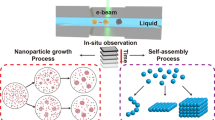Abstract
Heterophasic propylene-ethylene copolymers (HPEC) containing bis(2,2,6,6-tetramethyl-4-piperidinyl) sebacate (Tinuvin 770) as a hindered amine stabilizer (HAS) were thermally aged at 393 and 433 K. Two types of HPEC were examined, containing 25% and 10% ethylene (E), respectively, as ethylene/propylene rubber (EPR). Electron spin resonance (ESR) spectra of nitroxide radicals in HPEC were studied in the temperature range 100–433 K; the nitroxides were derived from the HAS and are termed HAS-NO. The results were compared with ESR spectra of the same radicals obtained first by oxidation of Tinuvin 770 and then were doped in HPEC and related homopolymers, polyethylene (PE) and polypropylene (PP); these nitroxides are termed “spin probes.” ESR spectra indicated that HAS-NO and the spin probes reside in a range of amorphous sites differing in their dynamic properties. The relative population of the sites was explained by assuming that the crystalline domains exert a restraining effect on chains located in vicinal amorphous domains. Spatial and temporal effects of the aging process were studied by ESR and ESR imaging (ESRI) of HAS-derived nitroxide radicals, and by FTIR of films prepared by compression molding. 1D ESRI enabled the visualization of an outer region of thickness ≈100 μm that contained a lower amount of nitroxides, and is believed to result from the loss of the stabilizer by diffusion (“blooming”) and possibly also in chemical reactions during aging. Two-dimensional spectral-spatial ESRI indicated the presence of nitroxide radicals in two amorphous sites, fast and slow; the corresponding relative intensity varied with sample depth. Both ESRI and FTIR experiments suggested a faster degradation rate in HPEC containing 25% E, as compared to 10% E; moreover, a larger Tinuvin 770 content in the polymers led to less efficient stabilization. FTIR spectra indicated increased ordering of polypropylene segments in HPEC during aging at 433 K.
Similar content being viewed by others
References
Pukansky, B., in Polymeric Materials Encyclopedia, Salamone, J.C. (Ed.), CRC Press, Boca Raton, FL, 6615, 1996.
Tullo, A.H., Chem. Eng. News, 79, p. 10 (2001).
Albizzati, E., Giannini, U., Collina, G., Noristi, L., and Resconi, L., in Polypropylene Handbook, Moore, E.P. Jr. (Ed.), Hanser Publishers, Munich, Chapter 2, p. 92, 1996.
Mirabella, F.M. Jr. and McFaddin, D.C., Polymer, 37, 931, and references therein (1996).
Xu, J., Feng, L., Yang, S., Wu, Y., Yang, Y., and Kong, X., Polymer, 38, 4381 (1997).
Zhu, X., Yan, D., and Fang, Y., J. Phys. Chem. B, 105, 12461 (2001).
Fan, Z.Q., Zhang, Y.-Q., Xu, J.-T., Wang, H.-Tao., and Feng, L.-X., Polymer, 42, 5559 (2001).
Morris, H.R., Monroe, B., Ryntz, R.A., and Treado, P.J., Langmuir, 14, 2426 and references therein (1998).
Pennington, B.D., Ryntz, R.A., and Urban, M.W., Polymer, 40, 4795 (1999).
Fitchmun, D.R. and Mencik, Z., J. Polym. Sci. Polym. Phys. Ed., 11, 951 (1973).
Kruczala, K., Varghese, B., Bokria, J.G., and Schlick, S., Macromolecules, 36, 1899 (2003).
Kruczala, K., Bokria, J.G., and Schlick, S., Macromolecules, 36, 1909 (2003).
Motyakin, M.V., Gerlock, J.L., and Schlick, S., Macromolecules, 32, 5463 (1999). (b) Kruczala, K., Motyakin, M.V., and Schlick, S., J. Phys. Chem. B, 104, 3387 (2000). (c) Motyakin, M.V. and Schlick, S., Macromolecules, 34, 2854 (2001). (d) Motyakin, M.V. and Schlick, S., Polym. Degrad. Stab., 76, 25 (2002). (e) Motyakin, M.V., and Schlick, S., Macromolecules, 35, 3984 (2002).
Varghese, B. and Schlick, S., J. Polym. Sci. Part B: Polym. Phys., 40, 415 (2002); (b) Varghese, B. and Schlick, S., J. Polym. Sci. Part B: Polym. Phys., 40, 424 (2002).
Lucarini, M. and Pedulli, G.F., Makromol. Chem., 252, 179, and references therein, (1997).
Goldberg, D.E., Genetic Algorithms in Search, Optimization and Machine Learning, Addison-Wesley, Reading, 1989, (b) Michalewicz, Z., Genetic Algorithms+Data Structures=Evolution Programs, Springer-Verlag, Berlin, 1992.
Hartke, B., J. Chem. Phys., 97, 9973 (1993).
Maltempo, M.M., Eaton, S.S., and Eaton, G.R., in EPR Imaging and In Vivo EPR, Eaton S.S., Eaton, G.R., and Ohno, K. (Eds.), CRC Press, Boca Raton, FL, Chapter 14, p. 145, 1991.
Marek, A. and Schlick, S., unpublished work from this laboratory.
Gillen, K.T. and Clough, R.L., Polymer, 33, 4359 (1992).
Cheng, S.Z.D. and Wunderlich, B., Macromolecules, 21, 789 (1988).
Wunderlich, B., Thermal Analysis, Academic Press, Boston, 1990, (b) Prog. Polym. Sci., 28, 383 (2003).
Flory, P.J., J. Phys. Chem., 17, 233 (1949).
Malik, J., Hrivik, A., and Tuan, D.Q., in Polymer Durability: Degradation, Stabilization and Lifetime Prediction, Clough, R.C., Billingham, N.C., and Gillen K.T. (Eds.), Advances in Chemistry Series 249, American Chemical Society, Washington, D.C., Chapter 29, p. 455, 1996.
Franchi, P., Lucarini, M., Pedulli, G.F., Bonora, M., and Vitali, M., Macromol. Chem. Phys., 202, 1246, and references therein (2001).
Dudler, V., Polym. Degrad. Stab., 42, 205 (1993).
Delprat, P., Duteurtre, X., and Gardette, J.-L., Polym. Degrad. Stab., 50, 1 (1995).
Gensler, R., Plummer, C.J.G., Kausch, H.-H., Kramer, E., Pauquet, J.-R., and Zweifel, H., Polym. Degrad. Stab., 67, 195 (2000).
Author information
Authors and Affiliations
Corresponding author
Rights and permissions
About this article
Cite this article
Schlick, S., Kruczala, K. Spatially resolved degradation in heterophasic polymers by ESR imaging and FTIR: The case of propylene-ethylene copolymers. J Coat. Technol. Res. 2, 389–397 (2005). https://doi.org/10.1007/s11998-005-0006-x
Issue Date:
DOI: https://doi.org/10.1007/s11998-005-0006-x




